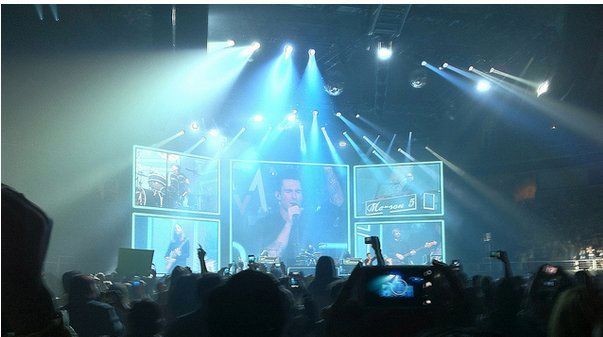
Recently I took my daughter and one of her classmates, who both are turning 14, to the Maroon 5 concert in San Jose. In the Virginia of my childhood, concerts were raucous and druggy affairs; you could get a contact high taking a deep breath at a Doobie Brothers show (before Michael McDonald joined, anyway). Here in Silicon Valley, things are different. When we reached the HP Pavilion, the entrance was cordoned off; instead of walking right in, we had to go through a long barricade that diverted us away from the door, only to dissolve back into chaos once we got up to the entrance.
"Typical crappy HP interface," someone behind me said.
Welcome to a rock concert in the Bay Area, where you can overhear offhand UX slams.
The venue bans cameras during concerts, but it turns out that this rule is taken about as seriously as Greek tax law: it seemed like everybody had a smartphone, and was taking pictures throughout the show. At first, I thought this was going to be a big distraction, and that it was a shame that kids today (and their parents -- there were lots of families at the show) couldn't put their phones down long enough to listen to one of the world's biggest rock groups. Too often, after all, it seems our kids are transfixed by screens when we could be engaged with the world.
But as the evening went on, I got up and wandered around a bit, and saw only a couple kids who really seemed focused on their phones at the expense of the show. Most teens were doing more interesting things with their phones, and they illustrate how complicated our relationships with devices has become -- and how we can make them more positive.
Sometimes the smartphone functions as the modern cigarette lighter (remember those?). This became clear during opening act Owl City's song "Fireflies," when the venue lit up with people holding up their phones. The whole place glowed.
The concert was fabulously high-tech. The lighting -- half the lights were lasers, not traditional spotlights -- roved everywhere, and it was fantastically well-choreographed. There a huge projection system behind the stage, and alternately showed filmed scenes and live shots of the band. For fans sitting far from the stage, this is a great blessing: Some may complain that seeing Adam Levine onscreen is inauthentic (why not just stay home and watch the videos?), but it's a lot better than seeing him ant-sized.
In this kind of environment, with screens forming the backdrop of the stage, suspended over the crowd, and even wrapped around the synthesizers and risers, the crowd's smartphones weren't out of place: they were another piece of the lighting, a technology breaking down the wall between the crowd and the stage. A couple songs into their set, I realized that as Adam Levine moved around the stage, a wave of smartphones would rise up and down, following him as if magnetically attracted them.
Now, there are environments where everyone having their phones out is terribly distracting: think of the last time you were at a restaurant and your kids were texting their friends. But in a context where the ambient sound level was hovering around 95 decibels -- loud enough to feel the drums in your bones -- and you could read Moby Dick by the lasers and strobe lights, the smartphones were more like bits of the stage screens, broken free and scattered out into the crowd. For most of the audience the point of the camera wasn't just to record the show, but to be part of the show.
It was also striking what I didn't see. Nobody seemed to be using Instagram during the show: you can fuss with filters and effects when you're taking a picture of a sandwich, not when the band is about to wheel into "Hands All Over." And there was lots of texting between acts, but far less during the show.
My daughter and her friend got into the act, too. They shared an iPhone (and occasionally borrowed mine), taking pictures, looking at them together, waving the screen whenever Adam looked their way. Again, it wasn't a distracting technology: for them, it was a way of joining in the fun, and something that made it more of a shared experience.
Afterwards, when they were back home, they both got onto Facebook and gushed about how great the show was, how their ears were ringing, and all the rest. (Oddly, I didn't get mentioned in their posts..) But while they were at the show, they were there.
So what's this mean?
Lots of parents worry about how technology makes our kids more distracted, less able to be in the moment. Starting down at the screen means missing out on the world around them, and Facebook messages block out conversation with people at the same table.
And yes, this happens. Absolutely. But the concert showed that the same technology can be used to become part of an event: to record some of it, yes, but more important, to become more involved in it.
In other words, while our technologies can enable bad behavior, they don't determine it; we can use those same devices in ways that bring us more into the moment, and connect us more to the people beside us.
Our challenge is to help our kids learn to pay more attention to how they use smartphones and social media; to notice when they're using these technologies in ways that are distracting or socially disruptive; and to help them find practices that feel and work better.
And the show was awesome, even if the only thing smoking was the dry ice.